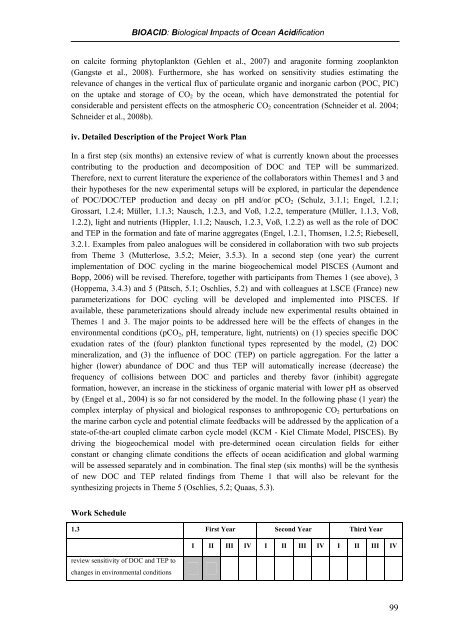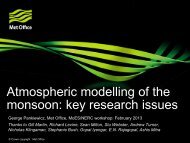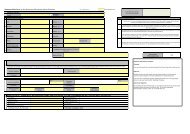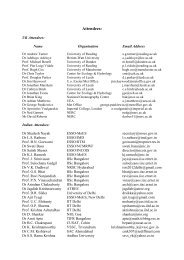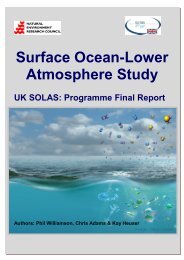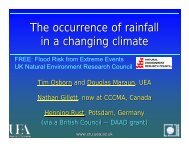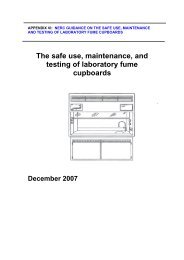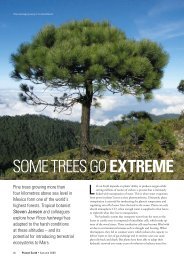BIOACID Programme - Natural Environment Research Council
BIOACID Programme - Natural Environment Research Council
BIOACID Programme - Natural Environment Research Council
Create successful ePaper yourself
Turn your PDF publications into a flip-book with our unique Google optimized e-Paper software.
<strong>BIOACID</strong>: Biological Impacts of Ocean Acidification<br />
on calcite forming phytoplankton (Gehlen et al., 2007) and aragonite forming zooplankton<br />
(Gangstø et al., 2008). Furthermore, she has worked on sensitivity studies estimating the<br />
relevance of changes in the vertical flux of particulate organic and inorganic carbon (POC, PIC)<br />
on the uptake and storage of CO2 by the ocean, which have demonstrated the potential for<br />
considerable and persistent effects on the atmospheric CO2 concentration (Schneider et al. 2004;<br />
Schneider et al., 2008b).<br />
iv. Detailed Description of the Project Work Plan<br />
In a first step (six months) an extensive review of what is currently known about the processes<br />
contributing to the production and decomposition of DOC and TEP will be summarized.<br />
Therefore, next to current literature the experience of the collaborators within Themes1 and 3 and<br />
their hypotheses for the new experimental setups will be explored, in particular the dependence<br />
of POC/DOC/TEP production and decay on pH and/or pCO2 (Schulz, 3.1.1; Engel, 1.2.1;<br />
Grossart, 1.2.4; Müller, 1.1.3; Nausch, 1.2.3, and Voß, 1.2.2, temperature (Müller, 1.1.3, Voß,<br />
1.2.2), light and nutrients (Hippler, 1.1.2; Nausch, 1.2.3, Voß, 1.2.2) as well as the role of DOC<br />
and TEP in the formation and fate of marine aggregates (Engel, 1.2.1, Thomsen, 1.2.5; Riebesell,<br />
3.2.1. Examples from paleo analogues will be considered in collaboration with two sub projects<br />
from Theme 3 (Mutterlose, 3.5.2; Meier, 3.5.3). In a second step (one year) the current<br />
implementation of DOC cycling in the marine biogeochemical model PISCES (Aumont and<br />
Bopp, 2006) will be revised. Therefore, together with participants from Themes 1 (see above), 3<br />
(Hoppema, 3.4.3) and 5 (Pätsch, 5.1; Oschlies, 5.2) and with colleagues at LSCE (France) new<br />
parameterizations for DOC cycling will be developed and implemented into PISCES. If<br />
available, these parameterizations should already include new experimental results obtained in<br />
Themes 1 and 3. The major points to be addressed here will be the effects of changes in the<br />
environmental conditions (pCO2, pH, temperature, light, nutrients) on (1) species specific DOC<br />
exudation rates of the (four) plankton functional types represented by the model, (2) DOC<br />
mineralization, and (3) the influence of DOC (TEP) on particle aggregation. For the latter a<br />
higher (lower) abundance of DOC and thus TEP will automatically increase (decrease) the<br />
frequency of collisions between DOC and particles and thereby favor (inhibit) aggregate<br />
formation, however, an increase in the stickiness of organic material with lower pH as observed<br />
by (Engel et al., 2004) is so far not considered by the model. In the following phase (1 year) the<br />
complex interplay of physical and biological responses to anthropogenic CO2 perturbations on<br />
the marine carbon cycle and potential climate feedbacks will be addressed by the application of a<br />
state-of-the-art coupled climate carbon cycle model (KCM - Kiel Climate Model, PISCES). By<br />
driving the biogeochemical model with pre-determined ocean circulation fields for either<br />
constant or changing climate conditions the effects of ocean acidification and global warming<br />
will be assessed separately and in combination. The final step (six months) will be the synthesis<br />
of new DOC and TEP related findings from Theme 1 that will also be relevant for the<br />
synthesizing projects in Theme 5 (Oschlies, 5.2; Quaas, 5.3).<br />
Work Schedule<br />
1.3 First Year Second Year Third Year<br />
review sensitivity of DOC and TEP to<br />
changes in environmental conditions<br />
I II III IV I II III IV I II III IV<br />
99


